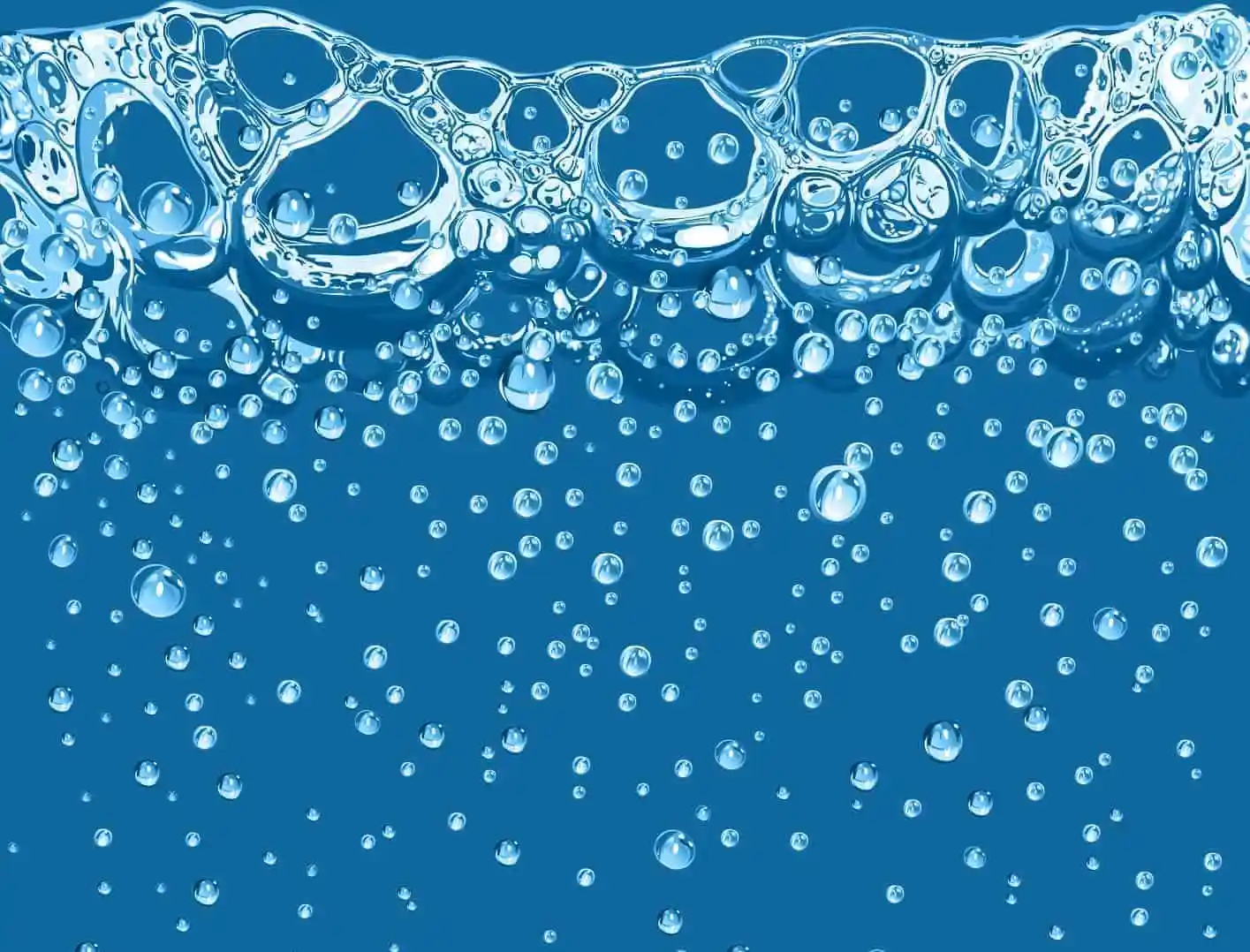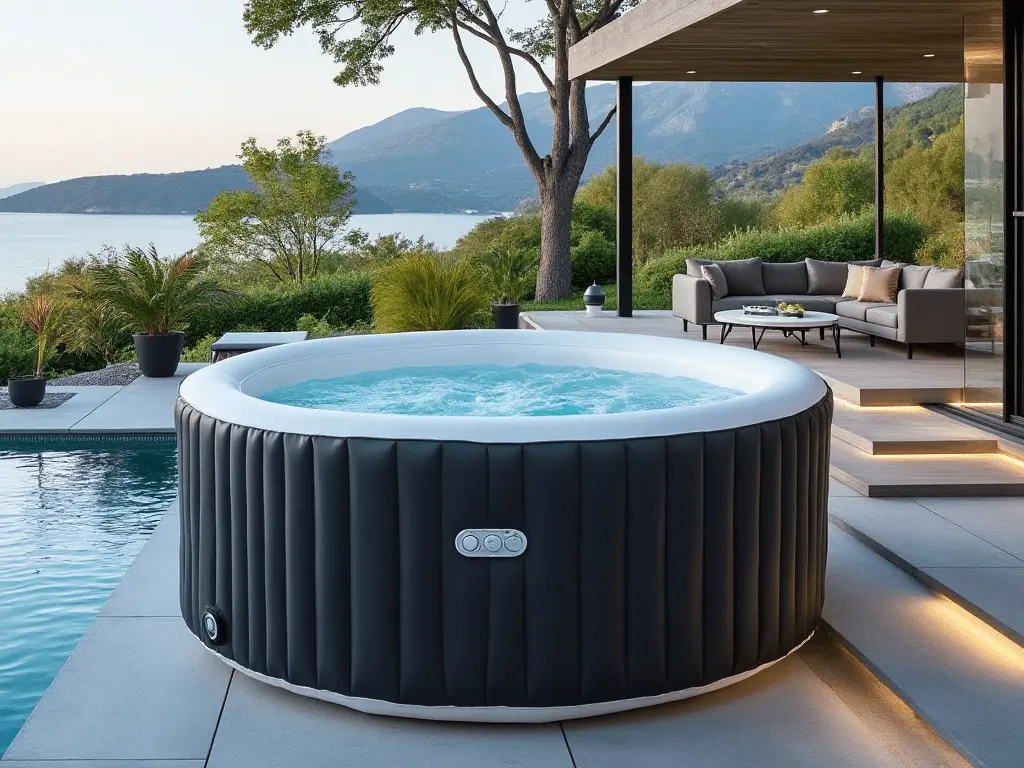Feeling stuck trying to pick the right hot tub size? We break down the benefits…

Are Inflatable Hot Tubs Worth It? See Why or Why Not Before You Buy!
If your hot tub is losing water but you can’t find a leak, it might not be a problem. Or it could be a big deal! Read this guide to learn when to call for help.
Are inflatable hot tubs worth it? They seem to have so much going for them! After all, you just need to blow it up, plug it in, fill it up from your garden hose, and wait for the water temperature to hit your personal sweet spot. Why go through the hassle of installing a spa when you can get the same hot tub experience with an inflatable model?
It’s not that simple, of course. Here’s what we want to show you:
- The pros and cons of inflatable hot tubs
- How they stack up against traditional models
- Key factors to consider before buying
Ready to find out if an inflatable hot tub is right for you?

Are Inflatable Hot Tubs Worth It? TL;DR
Inflatable hot tubs are worth it if you’re looking for an affordable, portable, and easy-to-set-up solution for occasional relaxation. We don’t have to tell you much about how they differ from normal hot tubs. They are temporary, not as durable, and lack the same level of insulation as a standard hot tub. But they are good at one thing: ease of use.
Here’s a quick comparison of how inflatables compare to traditional hot tubs.
| Key Considerations | Inflatable Hot Tub | Traditional Hot Tub |
| Budget | Ideal for those with a limited budget. | Higher initial cost, but a long-term investment. |
| Usage Frequency | Best for seasonal or occasional use. | Suited for frequent, year-round use. |
| Portability & Flexibility | Offers flexibility in placement and easy portability. | Fixed installation, ideal for a permanent location. |
| Features & Comfort | Basic features with less powerful jets. | Advanced features with ergonomic seating and strong jets. |
| Durability & Longevity | Shorter lifespan, typically 3-7 years. | Long-lasting, with a lifespan of 20+ years. |
| Space Considerations | Great for limited space and temporary setups. | Requires dedicated space for installation. |
| Property Value | Minimal impact on property value. | Can increase property value. |
Brief overview of hot tub types
Hot tubs come in two main types: traditional and inflatable.
- Traditional hot tubs are permanent fixtures made of acrylic, fiberglass, or wood. They require professional installation and are typically more expensive.
- Inflatable hot tubs are portable, made of durable PVC or vinyl, and can be set up and taken down as needed.
The differences are really obvious, but choosing still seems difficult. Let’s get into why this might be the case for you.
Growing popularity of inflatable hot tubs
Inflatable hot tubs have gained significant popularity in recent years. Their affordability, ease of installation, and portability make them an attractive option for many homeowners. You can easily move them to different locations in your yard or even take them with you when you relocate. The market for inflatable hot tubs has expanded, offering a wide range of models with various features and capacities.
Are Inflatable Spas Any Good? Key Benefits and Drawbacks
Many people wonder, “Are inflatable spas any good?” The short answer is yes, they can be a fantastic option for certain users, but they come with trade-offs. Inflatable hot tubs, often referred to as inflatable spas, offer a convenient and budget-friendly way to enjoy a relaxing soak at home. They’re particularly appealing if you want a spa experience without the hefty price tag or permanent commitment of a traditional hot tub. Let’s break down what makes them good and where they might fall short.
Why Inflatable Spas Are Good
- Affordability: Inflatable spas cost significantly less than traditional models, typically ranging from $300 to $1,000, making them accessible for budget-conscious buyers.
- Ease of Setup: You can set up an inflatable spa in just a few hours with minimal tools, perfect for those who want quick relaxation without complex installation.
- Portability: Their lightweight design means you can move them to different locations or store them when not in use, ideal for renters or small spaces.
Where They Fall Short
- Limited Features: Inflatable spas often have fewer jets and less powerful pumps, which may not deliver the same hydrotherapy experience as traditional hot tubs.
- Shorter Lifespan: Most inflatable spas last 2-5 years, compared to the 10-20 years you can expect from a traditional model.
- Energy Efficiency: Due to thinner insulation, inflatable spas can be more expensive to run, especially in cold climates.
So, are inflatable spas worth it? If you’re looking for an affordable, flexible option for occasional use, they’re a great choice. However, if you want a long-term, high-performance spa, a traditional hot tub might be a better investment. Consider your lifestyle and priorities to decide if an inflatable spa is good for you.
Do Inflatable Hot Tubs Work? Performance Insights
A common question we hear is, “Do inflatable hot tubs work?” Absolutely, they do! Inflatable hot tubs are designed to provide a relaxing, warm soak with bubbling jets, mimicking the core experience of a traditional hot tub. However, their performance depends on your expectations and how you plan to use them. Let’s explore how well they work and what you can expect.
How They Work
Inflatable hot tubs use an electric pump to inflate the structure and power the jets, while a built-in heater warms the water to your desired temperature, typically up to 104°F. Most models include digital controls for easy operation and basic filtration systems to keep the water clean. They’re plug-and-play, meaning you can set them up with a standard electrical outlet and a garden hose.
Performance Strengths
- Relaxation: Inflatable hot tubs deliver warm water and gentle jets, perfect for unwinding after a long day.
- Quick Setup: You can be soaking within hours of unboxing, making them highly convenient.
- Portability: Move them to different spots or take them to a vacation home with ease.
Performance Limitations
- Weaker Jets: The jets in inflatable hot tubs are less powerful, offering a lighter massage compared to traditional models.
- Slower Heating: It can take 12-24 hours to heat the water, which may require planning ahead.
- Noise: The pump can be noisy, which might disrupt a peaceful soak.
In summary, inflatable hot tubs work well for casual relaxation and are a practical choice for those who value convenience and affordability. If you’re after intense hydrotherapy or a premium spa experience, a traditional hot tub might better suit your needs.
Cost Comparison
One of the obvious advantages of inflatable hot tubs is they are much cheaper than a traditional hot tub. You can pick one up for a few hundred dollars, plop it down somewhere flat and level, and be soaking in just a few hours. But let’s get into a few details to help you understand just how much you could save with an inflatable model.
Initial purchase price
Inflatable hot tubs are a lot cheaper than traditional models in 2024. You can expect to pay between $300 to $1000 for a high quality inflatable hot tub. Traditional hot tubs, on the other hand, range from $3000 to $15,000 or more.
Installation expenses
Installation costs for inflatable hot tubs are minimal. You simply need a flat surface and access to electricity and hundreds of gallons of water. Traditional hot tubs require professional installation, which can cost $500 to $2000 or more. Additional expenses may include:
- Electrical upgrades
- Concrete pad or deck reinforcement
- Plumbing modifications
Of course, since inflatable hot tubs still weigh a lot when they are full of water, you’ll want to be careful setting one up on elevated floors. You could damage something just by the weight of the hot tub water.
If you’re weighing the cost of an inflatable vs. traditional model, check out this guide on the best hot tub for the money to understand which options offer the most value.
Long-term energy use and maintenance costs
Inflatable hot tubs and traditional hot tubs differ significantly in energy consumption, primarily due to their construction and insulation properties.
Inflatable Hot Tubs:
- Higher Energy Consumption: Inflatable hot tubs are generally less energy-efficient. They tend to lose heat more quickly due to inadequate insulation, requiring more energy to maintain desired water temperatures, especially in cooler climates.
- Heating Time: They typically heat water at a slower rate, around 1 degree per hour, compared to traditional hot tubs. This slower heating process can lead to increased energy use if the tub is frequently heated from a cold state.
- Overall Costs: While they may have lower initial costs, the ongoing electricity bills can accumulate, making them more expensive in the long run for regular users.
Traditional Hot Tubs:
- Lower Energy Consumption: Traditional hot tubs are designed with better insulation and more efficient heating systems. They can heat water at approximately 2 degrees per hour and maintain temperatures more effectively.
- Energy-Saving Features: Many modern traditional hot tubs include energy-saving modes and superior insulation, which significantly reduce operational costs over time.
- Long-Term Investment: Although the upfront cost is higher, traditional hot tubs often prove to be more economical regarding energy usage, especially for frequent users.
While inflatable hot tubs may seem like a budget-friendly option initially, they generally consume more energy compared to traditional hot tubs due to their inferior insulation and heating capabilities. If you really want to have a hot tub lifestyle for years to come, a traditional hot tub is likely to be a much wiser choice.
A good cover can make a big difference in keeping energy costs low. Explore hot tub covers designed to improve insulation and prevent heat loss.
Are They Expensive to Run? Operating Costs Breakdown
One of the top concerns for potential buyers is, “Are inflatable hot tubs expensive to run?” The answer depends on several factors, including your local electricity rates, how often you use the tub, and the climate you live in. Generally, inflatable hot tubs cost more to operate than traditional models due to their less efficient insulation, but they can still be budget-friendly for occasional use.
| Cost Factor | Inflatable Hot Tub | Traditional Hot Tub |
|---|---|---|
| Electricity (Monthly) | $20-$50 (based on 4-6 uses per week in moderate climates) | $15-$30 (better insulation reduces heat loss) |
| Water Treatment | $5-$15/month (chlorine/bromine, test strips) | $10-$20/month (larger water volume, more chemicals) |
| Repairs/Replacement | $50-$200/year (pumps, patches, or full replacement every 2-5 years) | $100-$500/year (parts like pumps or heaters, but longer lifespan) |
| Total Annual Cost | $300-$900 (varies by usage and climate) | $300-$600 (lower energy costs offset higher maintenance) |
To keep operating costs low, use a high-quality cover to reduce heat loss, run the tub during off-peak electricity hours, and maintain proper water chemistry to avoid costly repairs. For more tips on managing expenses, check out our guide on the cost of hot tub maintenance.
Portability and Space Considerations
Traditional hot tubs? They’re not going anywhere. Once they’re set up, they’re stuck there. Inflatable hot tubs, on the other hand, are totally portable. You can drain them, pack them up, and move them wherever you like.
Easy to Move
Inflatable hot tubs are so much easier to move than the traditional kind. You can just deflate them and relocate without much fuss, making them perfect for renters or anyone who likes to switch up their outdoor space now and then. Since they’re lightweight, you can do it all yourself without having to hire help, saving you time and money.
Convenient Storage
Not using your inflatable hot tub? No problem. Just deflate it and tuck it away in a closet, garage, or even under the bed. It’s a great option if you’re short on storage space or want to keep your outdoor area open during certain times of the year. Unlike traditional hot tubs that take up a permanent spot, you can reclaim your space whenever you want.
Great for Different Living Spaces
Inflatable hot tubs can fit into a variety of living situations, making them super versatile. They’re great for:
- Apartment balconies with weight limits
- Small patios or decks
- Rentals where you can’t make permanent changes
- Vacation homes or campsites
Whether indoors or outdoors, they let you enjoy a spa experience in places where a traditional hot tub just wouldn’t work. Plus, you can experiment with different spots around your property until you find the perfect one.
Perfect for Tight Spaces
If you don’t have much outdoor space, an inflatable hot tub can still give you that relaxing soak without taking over your whole yard. Inflate it when you’re ready to use it, and then store it away to keep your space clutter-free. It’s an ideal option for city dwellers or anyone with a small backyard who still wants the perks of a hot tub.
Durability and Lifespan
Which one of these is going to be better in the long run? Let’s look at build quality, wear and tear, and expected lifespan.
Material Quality
Inflatable hot tubs are typically made from PVC or vinyl, which aren’t as tough as the acrylic or fiberglass you’d find in traditional models. These materials can be more vulnerable to punctures or tears. That said, manufacturers have stepped up their game by adding reinforced walls and multi-layer designs to make them sturdier than before.
On the flip side, traditional hot tubs are built to last with solid materials like acrylic, fiberglass, or thermoplastic. These provide better insulation, can handle impacts well, and are generally much more durable overall.
Handling Wear and Tear
When it comes to wear and tear, inflatable hot tubs need a bit more TLC. They’re more likely to get damaged by sharp objects, heavy weight, or weather, so it’s important to choose the right spot and use them carefully. The good news is, many come with repair kits for those small fixes.
Traditional hot tubs really shine here. Their sturdy build can handle daily use, rough weather, and even accidental bumps without much fuss. You won’t have to deal with deflation or structural issues like you might with inflatable options.
How Long They Last
With proper care, you can expect an inflatable hot tub to last around 2-5 years. Its lifespan will depend on how often you use it, how well you store it, how you manage the water chemistry, and the kind of environment it’s exposed to.
Traditional hot tubs, however, can keep going strong for 10-20 years or even longer. Their durable build and permanent setup contribute to their long lifespan. With regular maintenance, you can get even more years out of them.
When comparing inflatable and traditional options, consider how long does a hot tub last and what factors can extend its lifespan, helping you make an informed decision.
Which Is Right for You?
When it comes to durability and lifespan, traditional hot tubs definitely have the upper hand. But inflatable hot tubs have come a long way and can be a budget-friendly, temporary solution if you’re not ready for the commitment of a permanent installation. Your choice will come down to how long you want it to last, your budget, and how willing you are to replace it more often.

Features and Performance
Jet Power and Massage
Inflatable hot tubs usually have fewer and less powerful jets than traditional models, typically offering between 60 and 140 jets for a gentle massage. Traditional hot tubs, with 150 to 300 jets, deliver stronger hydrotherapy and more strategic jet placement for targeted muscle relief. While inflatable tubs may not match this level of performance, newer models have improved, with some high-end options featuring adjustable jet pressure for a better massage experience.
To maximize your relaxation, consider how different hot tub jets can enhance massage capabilities, providing targeted relief for aching muscles.
Temperature Control
Temperature control has come a long way in inflatable hot tubs, with most now featuring digital controls for easy temperature adjustments. However, they generally take longer to heat up, often requiring 12-24 hours to reach the desired temperature. Traditional hot tubs heat faster and retain heat better, especially in colder weather. Some newer inflatable models include rapid heating features that help bridge the gap, but traditional tubs still tend to perform better year-round.
Energy Efficiency
Traditional hot tubs are generally more energy-efficient due to their superior insulation, which helps retain heat and lower energy consumption over time. Inflatable tubs, with their thinner walls, lose heat more easily, leading to higher energy use. However, they consume less energy when not in use, as they can be deflated and stored. Some newer inflatable models come with better insulation and energy-saving modes, making them more efficient than older versions. When comparing energy costs, consider how often you plan to use the hot tub and your local climate.
Wondering about energy consumption? Learn how much electricity does a hot tub use and discover tips for minimizing energy bills while keeping the water warm and soothing. If energy efficiency is a priority, look into the most energy-efficient hot tubs to find models that offer excellent insulation and lower operating costs.
Maintenance and Upkeep
Cleaning
Inflatable hot tubs are generally easier to clean. Their smooth surfaces resist algae and bacteria, so a weekly wipe-down with mild soap and water usually does the trick. Avoid abrasive cleaners that could damage the material. To prevent mold, make sure to empty and dry the tub completely between uses.
Traditional hot tubs need more effort. You’ll have to scrub the shell, jets, and filters regularly. Deep cleaning every few months means draining the tub, using specialized cleaning products, and refilling, which can take several hours.
Water Treatment
Maintaining water quality in inflatable hot tubs is straightforward. You’ll need to keep pH and sanitizer levels in check, using chlorine or bromine. Testing the water 2-3 times a week and weekly shock treatments should keep things balanced.
Traditional hot tubs follow a similar routine but may need more frequent adjustments due to larger water volume and complex filtration. You might also need extra chemicals like algaecides to keep the water clear.
Keeping your water clean and safe is essential. This guide to hot tub water testing explains how to maintain the right balance of chemicals to ensure a healthy soaking experience.
Repairs and Replacement
While inflatable hot tubs aren’t as durable, repairs are usually easy and affordable. Most come with repair kits for small punctures, and components like pumps or heaters can be swapped out easily. If major damage occurs, replacing the whole tub is still cheaper than fixing a traditional one.
Traditional hot tubs are built to last but fixing them can be costly and complex, often requiring professional help for plumbing, electrical, or structural repairs. Replacing parts like pumps can be pricey, but with regular maintenance, they can last 15-20 years, compared to the 3-5 years you might get from an inflatable model.
The cost of hot tub maintenance can add up over time, but proper care can extend the life of your investment. Learn about expected costs and budget-friendly tips.
User Experience and Comfort
Seating
Inflatable hot tubs typically fit 4-6 people, offering a more open layout that lets you move around easily. This flexibility is great for socializing or adjusting your position. Traditional hot tubs, on the other hand, have molded seats designed for comfort and targeted massages, accommodating 2-8 people.
Noise
Inflatable hot tubs tend to be noisier due to the air pump that powers the jets, which can create a constant hum. This background noise might be distracting if you prefer a peaceful soak.
Traditional models are generally quieter, thanks to their solid construction and more efficient pumps, providing a calmer environment for relaxation and conversation.
Relaxation
Inflatable hot tubs offer a good soak with warm water and basic jets, making them convenient and portable. However, their massage power is usually less intense than traditional models.
Traditional hot tubs deliver a premium experience with stronger jets, better temperature control, and features like LED lighting or built-in speakers. You’ll enjoy deeper relaxation, targeted hydrotherapy, and greater comfort during long sessions.
Bottom Line
Inflatable hot tubs are great for occasional use, easy setup, and flexibility. Traditional hot tubs offer a long-lasting, luxury spa experience with enhanced comfort and therapeutic benefits. Your choice will depend on your needs, budget, and how much you’re looking to invest in relaxation.
FAQ
Are inflatable hot tubs cheaper than traditional ones?
Yes, they’re usually much more affordable, making them a budget-friendly choice for many homeowners.
How long do inflatable hot tubs last?
With proper care, they can last around 2-5 years. In comparison, traditional hot tubs typically last 10-20 years.
Can inflatable hot tubs be used year-round?
They’re not ideal for freezing temperatures. If you want year-round use in a cold climate, go with a traditional model.
Are inflatable hot tubs energy-efficient?
Not as much as traditional ones. The thinner walls and less insulation can lead to higher energy costs.
How easy are inflatable hot tubs to set up and maintain?
They’re pretty easy! You can inflate, fill, and get them ready in a few hours, with simple maintenance routines.
What’s the maximum capacity of inflatable hot tubs?
Most can fit 4-6 people, while traditional models can hold 8 or more.
Do inflatable hot tubs offer the same features as traditional ones?
They’ve improved, but you’ll generally find fewer features, limited jets, and less powerful pumps than in traditional models.
Is an inflatable hot tub worth it for small spaces?
Absolutely, if you have limited space! Inflatable hot tubs are ideal for small patios, balconies, or apartments since they can be deflated and stored when not in use. They offer a relaxing spa experience without requiring a permanent footprint, making them a worthwhile choice for urban dwellers or renters.
Final Verdict: Inflatable vs. Traditional Hot Tubs
Inflatable hot tubs are a great option for casual users, renters, or those with limited budgets and space. They’re perfect for occasional use and provide a convenient, seasonal spa experience.
However, if you’re seeking a long-term investment with superior comfort, durability, and advanced features, traditional hot tubs are the way to go. They offer stronger hydrotherapy, better temperature control, and can last for decades.
To make the best decision, learn how to choose a hot tub that fits your budget, space, and lifestyle. For a step-by-step approach to finding the perfect spa, check out our hot tub buying guide for critical questions to ask before purchasing.
For those exploring different hot tubs, Epic Hot Tubs offers a wide variety of options tailored to different needs, from space-saving models to luxurious, feature-rich designs.
At Epic Hot Tubs, we offer high-quality traditional models that provide unbeatable relaxation and value. With showrooms across North Carolina, expert guidance, and great deals, finding your perfect hot tub has never been easier. Whether you’re upgrading or investing in your first hot tub, let us help you enjoy luxury at home.

Ready to purchase a hot tub in NC?
Call us at 888-884-3742 or fill out the form below to get in touch with a member or our team.
Richard Horvath
Richard has been in the hot tub & spa industry for years. As a long hot tub & swim spa owner himself, Richard has a passion for helping homeowners create their dream backyard.



